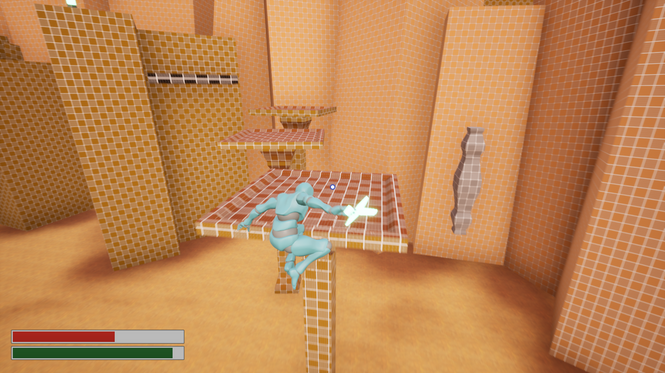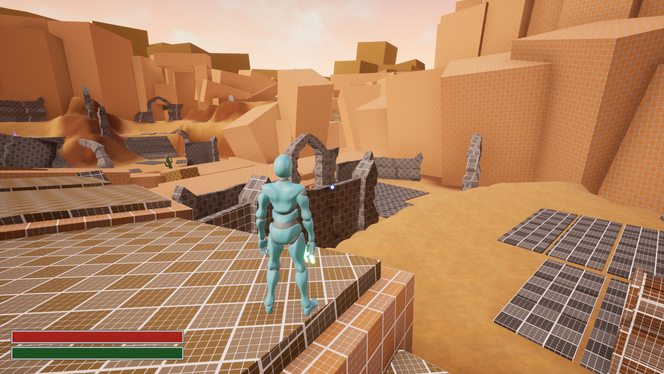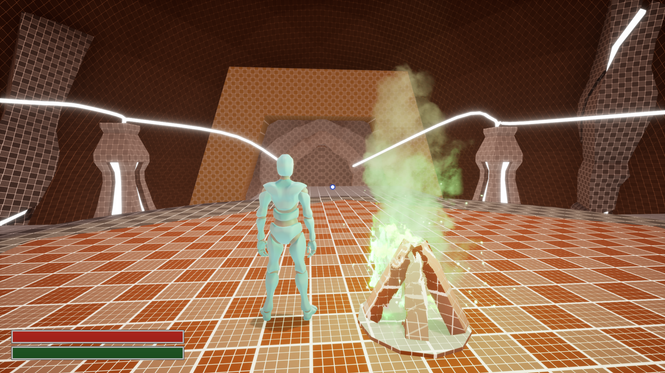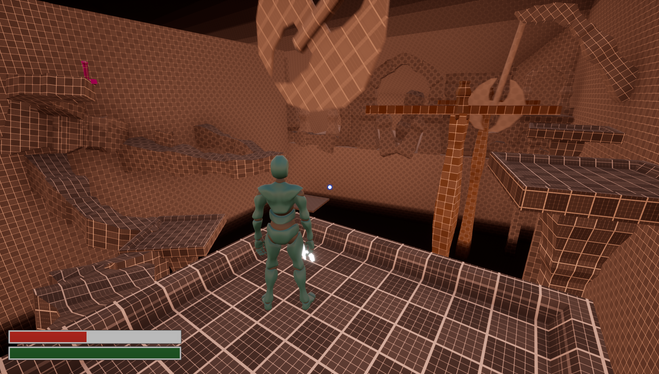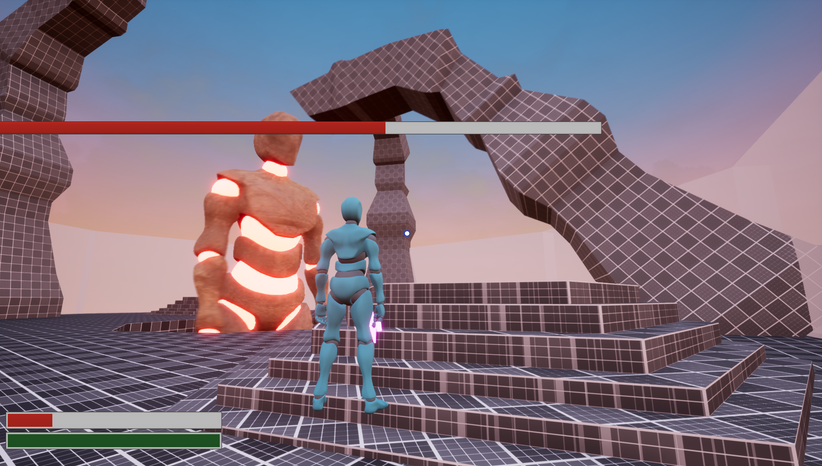FINAL MAJOR UNIVERSITY PROJECT
FRACTURE

PROJECT DETAILS
Duration: 6 Months
Engine: Unreal Engine 4
Team Size: 1
Tools Used: Blockout Tools (UE4 Marketplace), 3DS Max, Photoshop
CONTENTS
-
Pre-production (Technical design)
-
Creating the player controller
-
Scripting enemy NPCs and their behaviour
-
Implementing sword-fighting combat
-
Planning the Level (Research, 2D Map, Metrics Gym)
-
-
Production (Level Design)
-
Use the plans to begin blockout
-
Use 3D Modelling Software to create objects to communicate the environment
-
Create the first pass for each section of the level
-
Script events that occur in the second beat of the game
-
Balancing the flow and pacing of the level
-
Further developing the blockout
-
Adding wishlist features
-
INTRODUCTION
Fracture was a project for my final module at University. It is an action-adventure game with an overarching narrative to apply Level Design techniques for linear games.
My goal was to create a level that encouraged exploration, fighting enemies, and perfecting a movement ability in the player's kit.
Because this assignment was made with Level Design as an end goal, I decided to create my own player controller and NPC behaviour to practice visual scripting - with this in mind I identified different skills level designers require and how I was going to practice them:
-
Planning - Researching. Establishing the pacing, flow, and level beats. Creating a 2D Map. Using a Metrics Gym.
-
Visual Scripting - Creating player controller and NPC behaviour. Scripting events inside the level.
-
Building Experience - Creating a blockout in UE4. Modelling objects for the level.
-
Theory - Researching Level Design techniques for Linear levels. Applying the structure of the level. Using composition. Signposting. Gameplay opportunities for different playstyles. Optional side objectives.
Different Gameplay Styles
Since the level is linear, I made sure to mix up the gameplay styles and player mechanics so it doesn't become repetitive.

Multiple Ways to Approach Obstacles
Because there's never one true way to approach anything! Parts of the level provide different opportunities based on your playstyle - like sneaking past? Want to test your skill with the sword? Or do you prefer to take it slow by using your platforming abilities?

Hidden Collectibles
A way of engaging the player and encouraging exploration. Chests hidden across the level can allow players to set their own goals to hunt down as many as they can.


PRE PRODUCTION
Research
Before beginning my project I researched the types of environments my game will be set in and tutorials + resources that can help aid my development. I photobashed some concept art to give others a vision of my game.



Technical Design
-
Implemented the player's running, dashing, rolling, and sword fighting combat.
-
I created an NPC which can be placed in the level with different behaviours: Patrolling, Chasing, Strafing, Attacking, and Rolling.
-
I also worked on some events that could take place.



Planning
Time was managed through Trello and my own project roadmap. The purpose was to give an overview to my examiners of the direction I took this project when I did regular presentations on progress.
Upon reaching a state where I wanted to begin my level creation, I split the level into chunks and created structure, pacing, and other relevant diagrams to display my intentions. After finalizing this stage I created a 2D map to communicate the layout in its entirety.










A metrics gym was created to help me gauge distances so the player is aware of how far they can jump early in the game with consistent spaces between platforms.
This was also helpful to communicate other player mechanics such as rolling distances, jump height and crouch height for peers and tutors.


PRODUCTION
Part 1 - Exploring the Desert
To complete this section the players must:
-
Finish the tutorial and speak to an NPC
-
Defeat their first enemy and proceed to the acrobat challenge
-
Unlock the dash ability
-
Use the dash ability to jump over the ravine, blocking the way to the temple
-
Battle their way through the temple grounds and open the large door at the base of the temple.
The intention of this area was to:
-
Introduce the player to the controller
-
Introduce combat and elements of platforming
-
Make the player aware of hidden treasures early and encourage exploration
-
Reinforce mechanics as the player approaches the temple
-
Provide some focal points along the way as a general direction to the temple.

To Solve these points I:
-
Forced the player to engage with the environment to learn movement
-
Showed the player how enemies behave and the combat capabilities in a safe environment
-
Placed some seemingly obvious chests within the tutorial area and pathway to temple
-
Provided a set of puzzles while unlocking the dash to get players used to jumping / dashing distances
-
Used cutscenes and spatial composition to show the importance of the temple and which directions to head.
I made iterations throughout the project - I first wanted this area to open up into a desert, but this made the scene feel out of place and unnatural. Expanding the canyon range for this area also allowed me to create level boundaries and section areas for side activities.

Part 2 - Conquering the Temple
The intention of this area was to:
-
Test the player in two different areas of gameplay (combat and platforming)
-
Make the player feel a bigger challenge. More threats to overcome.
-
Feel a sense of progression through the door locks.
-
Overcome challenges within a time limit.
-
Give a solution to backtracking when completing the paths.


Platforming Challenge
Combat Challenge
Because of this I:
-
Made two different pathways to play through, both with a focus on different gameplay styles.
-
Created obstacles and encounters that had more of a threat to the player's health. These were split with checkpoints to give some challenge but also keeping it fair.
-
Made an event where the room fills with water overtime that the player must complete before drowning
-
Made both pathways loop back on themselves to prevent players having to go through the previous obstacles.
To complete this section the players must:
-
Figure out how to open the main doorway.
-
Battle or traverse their way through two different pathways to destroy the door's locks.
-
Learn the gameplay and player mechanics more to prepare for the final challenge.
-
Enter the final pathway when they are prepared.
Part 3 - Final Challenge and Boss
The intention of this area was to:
-
Throw every challenge at the player at once as a final test:
-
Dodging traps with dash
-
Rolling under timed spike traps
-
Destroying guardians with sword
-
Traversing the environment
-
Complete all these under a time limit
-
-
Give a 'final boss' feel that also tests the players engagement with the game.
-
Finish the game in a conclusive manner with a nicely composed scene.
Final Challenge
Boss Fight


To complete this section the players must:
-
Climb the final room of the temple to reach the summit.
-
Defeat the boss guarding the treasure
-
Boss is defeated by using its own attacks to destroy the environment
-
The attacks are sequential and force the player to move around the arena.
-
-
Use the hang glider to fly away, completing the demo.
Post Mortem
-
I think I set myself too much work on the technical side. Because of this, I didn't do as much Level Design work as I'd hoped (mainly polishing and iterating some challenges for the area in the temple). This was not completely wasted however as it taught me a lot about visual scripting with Blueprints.
-
I would have liked to have included some collectibles, as they can engage the player and encourage them to explore (even though the level is linear).
-
Some events in the level could have been more exciting: enemies jumping out as you approach the temple, or maybe areas of the level collapsing as you delve deeper.





